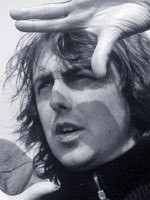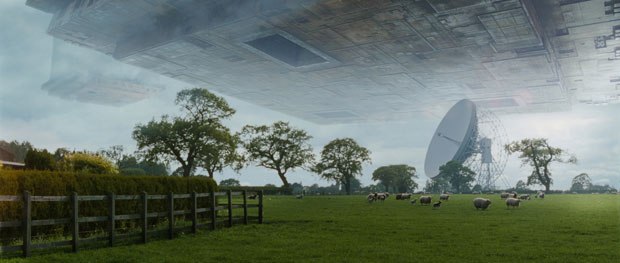Mary Ann Skweres hops aboard The Hitchhikers Guide to the Galaxy with the clever, creative vfx crew at Cinesite.
The Hitchhikers Guide to the Galaxy tells the tale of an ordinary guy, Arthur Dent (Martin Freeman), who with the help of his alien best friend escapes the exploding Planet Earth, hitchhiking into space in his pajamas and robe. Along the way he discovers the true nature of the universe, aided by the aforementioned electronic book, a guide to a crazy cosmos populated by creatures that include the two-headed, dim-witted president of the Galaxy (Sam Rockwell), a manic depressive robot (Alan Rickman), a megalomaniacal intergalactic missionary (John Malkovich) and a race of poetic, bad-tempered bureaucrats.

Since its creation as a radio series more than 25 years ago, Douglas Adams pop culture classic a mischievous mix of sci-fi, comedy, adventure and philosophy has morphed into a five-part trilogy of novels, a BBC television series, a groundbreaking computer game and the subject of college courses. And now, in his feature film debut, director Garth Jennings whimsical interpretation of the story finally journeys to the big screen with the help of visual effects supervisor Angus Bickerton and the digital effects team at Cinesite (Europe) in London, helmed by visual effects supervisors Adam McInnes, Matt Johnson and Sue Rowe, CG supervisor Jon Neill and visual effects producer Ken Dailey.
Bringing such a cultural phenomenon into the exacting medium of feature film was a task of galactic proportions. To bring it in on a tight budget mandated by Disney was infinitely more difficult and required the creative collaborators to think out-of-the-box. Bickerton complimented the director who got the project made from this complex book, Garths filmmaking style and sensibilities were right. He pitched practical, viable options. When he came up against a problem, he always relished the opportunity to think creatively. The project did not break any new ground in terms of technology, but rather relied on the cleverness of its collaborators to create this humorous escapade into the far reaches of the galaxy.
One of Jennings ideas was the visualization for the Improbability Machine, a new propulsion technology for crossing vast interstellar distances in a mere nothing of a second. A spaceship reaching Infinite Improbability passes through every point in the universe and can choose any particular point to arrive at. Like a slot machine, the spaceship cycles through random objects a lemon, cherries and even a watermelon before arriving in its true form at the destination. Its not the kind of effect that you get to do every day, admits Johnson. The Heart of Gold spaceship was a CG creation. The other objects were practical elements shot in front of a bluescreen and composited by Dan Harrod into the CG model of space created by Chas Cash.

The films production designer, Joel Collins, formulated most of the design ideas that the artists at Cinesite translated into 3D models. An important consideration in the concept was adding humor to the effects. Stylistically we had to make sure that the visual effects fit in with the style of the movie. We worked very hard to integrate the effects. They were sort of comedy visual effects, explains Johnson. The director didnt want it to be too perfect, He was always putting in these little quirky bits to help blend our stuff into the film. In the book, the Heart of Gold was sculpted in the form of a giant tennis shoe, but the production wanted something more visually exciting and modern. Ultimately the design became a spherical porcelain teapot with a blue mural willow pattern. This contrasted with the rectangular concrete blocks that made up the Vogons ships. 3D sequence supervisor, Simon Maddocks and 3D sequence lead, Angela Cole worked on the Heart of Gold.
President Zaphods head or more correctly heads, since he has two of them were perhaps the most challenging of the digital effects. The team had to be sensitive in the design because the universe of ardent fans had expectations from the reading the book. Even the latest state-of-the-art animatronics would not hold up, so the effect had to be created digitally. Jennings and screenwriter Karey Kirkpatrick knew that they didnt want a straightforward two-headed man. The idea that took hold was to make the second head pop out of the first like a Pez dispenser popping out its candy whenever the character got angry or excited. This eliminated the need for the head to be present every time the character was on screen. The head was created using an integrated mix of CGI and prosthetics. Sometimes actor Rockwell, who plays Zaphod, had to act with a prosthetic mold of his head on top of his head. At other times the head was added with CGI. Instead of hundreds of shots, this decision limited the effect to about thirty-five shots. It was a creative and economic decision, explains Bickerton. 3D supervisors Angela Cole and Jon Neill and 2D supervisor Stuart Partridge were principal contributors in creating Zaphods head.
The Planet Factory sequence was the most fun and successful effect, according to Dailey. That was a completely digital creation. It was one of the bigger shots, not an invisible effect, but one of the teams grand effects. It was the most time-consuming sequence according to Bickerton, We worked on the design of that all the way though production and post. It constantly evolved. It was one of the last finished and one of the first to get started. Honing, trying to get that space right was a long effort. In the finished film, the sequence has a fantastic, soaring score that forms a perfect fusion with the grand nature of the visual effect. 2D supervisor, Christian Zeh and 3D supervisor Thrain Shadbolt were key contributors to the effect.
On Vogoshere, the planet of the Vogons, the Paddles slap anyone with an original idea. The shooting of the scene on location was a battle of man versus the elements. Bickerton relates, That scene was shot in a quarry in Wales. It was bitterly cold. Horizontal rain. Everything you see was shot during two-minute gaps is the weather. In between shots we were huddling in vans. Laurent Cordier created the 3D modeling and texturing of the whacky paddles. George Plakides provided the 3D animation. Richard Little supervised 2D.
The Whale, an animatronic model created by Jim Hensons Creature Shop, was shot against a bluescreen and composited by Denis Scolan with the assistance of sequence lead Andy Robinson. Matte painted sky, 2D cutout cloud elements repositioned and reanimated in the computer and helicopter footage were combined to created the illusion of the ocean mammal plummeting to earth. A true sense of speed was achieved using dynamic sweeping moves and multi-planning techniques to give depth of movement and perspective shifts.
The Destruction of Earth was one of the most difficult shots. The shot pulls up from Arthur and Ford trying to get off the planet, coming up in a series of jumps to reveal the full Earth from space as it blows up, continuing into some Hitchhikers Guide animation and finally transitioning into the Vogon spaceship. That whole sequence was 4,500 frames long and took nine months to put it together, shares Dailey. Jennings had some very specific ideas so it took a lot of matte painting, design work and previs before the team got to the stage of actually doing the shot. 2D sequences supervisor Jan Toensmann worked on the shot.

Humma the religious cult leader played by Malkovich was created by combining practical on-set effects with CGI electronic legs and eye sockets. Stuart Partridge supervised the shoot, tracking Malkovich gliding on a camera dolly through a table with its center section removed. Sally Goldberg animated the 3D metallic spider legs, including one broken and bent limb a personification of the humorously twisted creativity apparent in much of the film. Michael Illingworth composited using Houdini and Discreet Inferno. 3D lighting was added by Bruno Lesieur and Sebastien Beaulieu.
The Crabs were a full CG creation that the team spent months perfecting. Based on an actual two-foot across model built by the production designer, Laurent Cordier modeled the crab in 3D Maya and textured it using Photoshop. Dynamic moves were animated by Kevin Modeste and Lesieu. For the Crabs as well as the Heart of Gold Spaceship, a new lighting pipeline was enacted that Cinesite had been developing. Johnson explains, The new lighting pipeline automatically rendered about twenty different passes of CG, so when those elements were given to the 2D artists they were able to have a large amount of creative control in fitting the CG into the live action plate. That gave a lot of flexibility and the ability to accommodate Garths requests.
The concept for the iconic character Deep Thought a mega-gigantic supercomputer contemplating the Ultimate Answer to Life was a combination of Rodins Thinker plus massive size. The fanciful result was produced using digital matte painting created by Dave Early, head of digital matte painting, and Patrick Zentis then composited by Carlo Scaduto and Guy Elson.
The Cinesite team created other diverse sequences that covered a range of effects, including Earth Version 2, supervised by 3D sequence lead Michael Grobe and the MICE effect, guided by 2D supervisor Jan Toensmann and 3D supervisor Ivor Middleton. The crew consisted of more than 110 artists plus scanning support and tech services. Various tools were used to complete the more than 500 visual effects. These included Shake with 2D plug-ins, Inferno, 3D Maya and Houdini.
The results of this successful creative collaboration are obvious. The Hitchhikers Guide to the Galaxy jets the viewer on a capricious adventure across the universe with the spirit of irreverence and quirky wit true to the original story.
Mary Ann Skweres is a filmmaker and freelance writer. She has worked extensively in feature film and documentary post-production with credits as a picture editor and visual effects assistant. She is a member of the Motion Picture Editors Guild.










